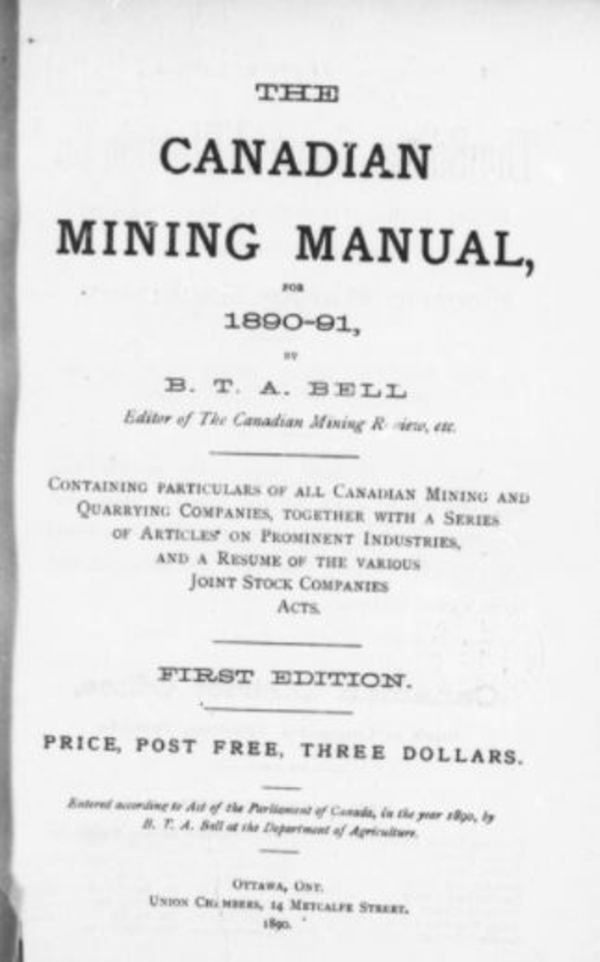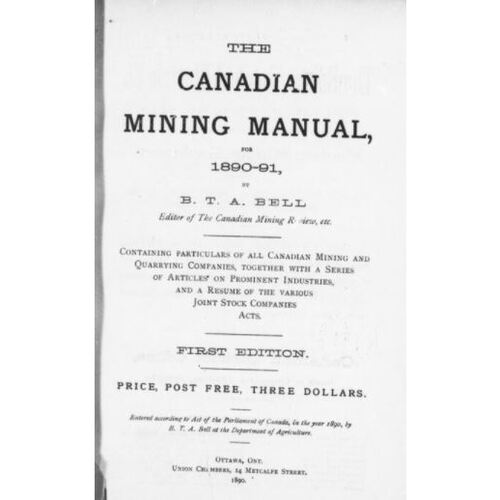
Source: Link
BELL, BENJAMIN TAYLOR A., militiaman, sportsman, journalist, editor, and publisher; b. 2 July 1861 in Edinburgh, son of David Bell and Margaret Taylor; m. 2 Jan. 1889 Sydney MacCarthy, and they had one son; d. 1 March 1904 in Ottawa.
Benjamin Taylor Bell received his education in private schools and at Stewart’s College in Edinburgh; he was given the initial A to distinguish him from a fellow student, also named Benjamin Taylor Bell. Of an adventurous disposition, he ran away to London, whence he was returned to Edinburgh by his father, who then placed him in an engineering firm. He joined the Edinburgh Volunteer Rifle Brigade. After the death of his mother, he immigrated to Canada, landing at Halifax early in 1882 and leaving immediately for Brandon, Man. Like many immigrants, Bell lacked both capital and farming experience, and within a year he was employed by the Canadian Pacific Railway as a clerk in the freight department at Winnipeg. Here he joined the 90th (Winnipeg) Battalion of Rifles, formed by William Nassau Kennedy* in 1883. His duties with the CPR found him in Rat Portage (Kenora, Ont.) in 1884 when a group of men recruited by Kennedy passed through on its way to take part in the expedition to relieve Major-General Charles George Gordon at Khartoum in the Sudan. Bell impulsively handed in his resignation to the CPR and joined the group, which included others like Bell who had no qualifications beyond an adventurous disposition and no experience as boatmen, and who hence encountered serious difficulties on the Nile [see Frederick Charles Denison*].
Upon the demobilization of the contingent in London in 1885, Bell returned to Montreal, where he obtained a commission as lieutenant in the 1st (Prince of Wales’s) Regiment of Volunteer Rifles, expecting to be sent west to assist in the suppression of the North-West rebellion. The Rifles were never ordered into active service, however, and Bell, who later transferred to the 43rd (Ottawa and Carleton) Battalion of Rifles, turned his hand to journalism. He wrote for the Montreal Gazette and the Montreal Daily Witness. He was also for a short time in 1886 editor of the Canadian Athletic News, a position that presumably reflected his abilities at cricket, a game with considerable status in Victorian Canada. A member of the Canadian International Eleven, Bell was part of the team which won at an international cricket match in New Jersey in 1886, and he was chosen to go to England the next year as a member of the Canadian team.
It was in 1887 that Bell found his life’s work when he assumed the editorship in Ottawa of the monthly Canadian Mining Review, until then a minor journal concerned with the promotion of the phosphate industry. Henceforth all his energies were devoted to the Canadian mining industry. He transformed the Review into what he proudly termed “the representative exponent of the Canadian Mineral and Mining Industries,” and it became the clearing-house for information in an industry in which rumour and speculation were the breath of life. Every issue contained a survey of the state of the mining industry, not only in Canada but throughout North America. Originally an employee of the Review, Bell soon became joint owner with W. A. Allan and, in 1896, sole proprietor. He continued as publisher of the Review until his death. He also acted as Canadian correspondent for a number of British journals with similar interests, such as the Iron and Coal Trades Review and the Engineering Review aid Metal Worker (both published in London), and was editor of the annual Canadian mining manual (Ottawa).
Along with his journalistic endeavours, Bell was active in helping to organize associations on behalf of the mining industry. Beginning at the provincial level, he became founding secretary of the General Mining Association of the Province of Quebec, created in 1891 in reaction to a bill introduced by Honoré Mercier*’s government on mineral rights, and was closely associated with the Mining Society of Nova Scotia, established in 1892. In 1894 he formed the Ontario Mining Institute. Then, in 1896, Bell was instrumental in persuading the provincial associations to come together in the Federated Canadian Mining Institute, which would publish the papers and proceedings of the provincial institutions in an annual volume intended to be representative of the entire country. The attempt at federation was short-lived and the institute dissolved itself at its second annual meeting in January 1898. It was succeeded by the Canadian Mining Institute, with provision for direct membership and fees. Bell, secretary of the institute and its driving force from 1898 until his death in 1904, saw membership rise from 63 to 480. The organization served both as a political lobby group for the mining industry and as a forum for the presentation and publication of papers relating to Canadian mining. Bell was also involved in efforts to publicize Canadian mining abroad. He helped organize in 1889 the visit to Canada of the American Institute of Mining Engineers and, in the following year, tours by similar groups from the United Kingdom and Germany.
Given his close association with the mining industry, it was only natural that Bell would become a spokesman for it. He played a leading role in the opposition to an attempt in 1900 by the Ontario government to place a “manufacturing condition” on the nickel ore of the Sudbury district, a policy which would have made the export of unrefined nickel ore and matte from the province prohibitively expensive [see Samuel J. Ritchie]. Bell was a prominent member of a delegation to Ottawa in 1901 requesting the federal government to disallow the offending legislation as it had the earlier Quebec legislation. His status within the industry was perhaps best illustrated by his appointment in 1903 as a commissioner, along with Byron Moffatt Britton, to investigate mining in the Yukon, a commission established in response to resentment in the Yukon towards the exclusive concession granted by the federal government to a syndicate led by Arthur Newton Christie Treadgold*.
Bell took part in the sittings of the commission but did not live to see the report issued. The circumstances of his death were somewhat bizarre. To reach the offices of the Canadian Mining Review he was in the habit of taking a short cut through an adjacent store. Unaccountably, on his way to work on 18 Feb. 1904 he walked through a wrong door in the store, falling ten feet into an empty elevator shaft. He died of his injuries less than two weeks later.
GRO-E, St George dist., Edinburgh, reg. of births, 2 July 1861. Globe, 1, 3 March 1904. Ottawa Citizen, 3 Jan. 1889. Can., House of Commons, Debates, 11 June 1903. Canadian annual rev. (Hopkins), 1901: 45–46; 1903: 237–38; 1904: 602. Canadian men and women of the time (Morgan; 1898). Canadian Mining Rev. (Ottawa), 9 (1890), no.1; 23 (1904): 22, 37–39; also reports of annual meetings of the Federated Canadian Mining Institute and its successor, the Canadian Mining Institute, 15 (1896)–23. Dominion annual reg., 1886. W. M. Goodwin, “The Institute, 1898–1948,” Canadian Mining and Metallurgical Bull. (Montreal), 41 (1948): 119–21.
Cite This Article
Angus D. Gilbert, “BELL, BENJAMIN TAYLOR A.,” in Dictionary of Canadian Biography, vol. 13, University of Toronto/Université Laval, 2003–, accessed December 25, 2025, https://www.biographi.ca/en/bio/bell_benjamin_taylor_a_13E.html.
The citation above shows the format for footnotes and endnotes according to the Chicago manual of style (16th edition). Information to be used in other citation formats:
| Permalink: | https://www.biographi.ca/en/bio/bell_benjamin_taylor_a_13E.html |
| Author of Article: | Angus D. Gilbert |
| Title of Article: | BELL, BENJAMIN TAYLOR A. |
| Publication Name: | Dictionary of Canadian Biography, vol. 13 |
| Publisher: | University of Toronto/Université Laval |
| Year of publication: | 1994 |
| Year of revision: | 1994 |
| Access Date: | December 25, 2025 |



